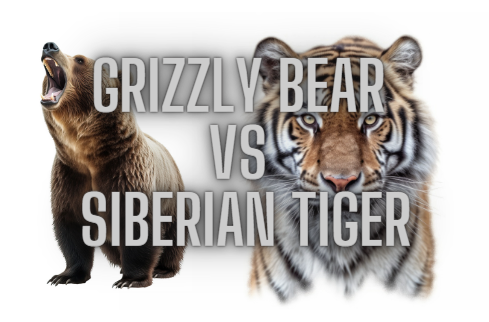The grizzly bear and the Siberian tiger are two of the most powerful and formidable predators on Earth. Their sheer size, strength, and predatory prowess make them apex predators in their respective habitats. In this article, we will explore the characteristics, hunting strategies, and territorial behaviors of these magnificent creatures. Join us as we delve into the hypothetical matchup between the grizzly bear and the Siberian tiger, imagining a thrilling clash between two titans of the animal kingdom.
Physical Attributes and Characteristics
The grizzly bear (Ursus arctos horribilis) is a large subspecies of the brown bear native to North America. Adult males can weigh up to 1,500 pounds (680 kilograms) and stand about 8 feet (2.4 meters) tall when on their hind legs. They possess immense strength and powerful forelimbs armed with long, sharp claws.
The Siberian tiger (Panthera tigris altaica) is the largest subspecies of tiger and inhabits the forests of eastern Russia. Adult males can weigh up to 660 pounds (300 kilograms) and reach lengths of around 10 feet (3 meters). They are known for their muscular build, powerful jaws, and retractable claws.
Hunting Strategies and Adaptations
Grizzly bears are primarily omnivorous, but they also possess predatory skills. When hunting, they employ a combination of strength, speed, and surprise. Grizzlies are known for their ability to catch and kill ungulates such as elk and moose, as well as smaller mammals. They are skilled at ambushing their prey, using their powerful forelimbs and long claws to strike with devastating force. Grizzlies are also adept at fishing, taking advantage of salmon runs during certain times of the year.
The Siberian tiger is a highly efficient carnivore, specializing in hunting large ungulates such as deer and wild boar. These tigers are stealthy and patient predators, relying on their exceptional camouflage and stalking skills to get close to their prey. With a burst of speed, they can pounce on their target, delivering a swift and lethal bite to the neck or throat. Siberian tigers are also known for their powerful forelimbs, which enable them to bring down large prey.
Territorial Behavior and Encounters
Grizzly bears are solitary animals with vast home ranges. They establish territories that encompass sufficient food resources and suitable habitats. The size of a grizzly bear’s territory can vary depending on factors such as food availability, population density, and gender. While grizzlies are generally tolerant of other bears within their territories, they can display aggression towards intruders, especially during the mating season or when defending cubs.
Siberian tigers are also solitary creatures, with males occupying larger territories than females. They mark their territories with scent markings and engage in vocalizations to communicate their presence to other tigers. Similar to grizzly bears, Siberian tigers can exhibit territorial aggression if their boundaries are challenged by intruders. However, direct encounters between grizzly bears and Siberian tigers in the wild are extremely rare due to their different habitats and geographical ranges.
Hypothetical Battle: Assessing Strengths and Weaknesses
In a hypothetical confrontation between a grizzly bear and a Siberian tiger, several factors come into play.
Size and Strength: The grizzly bear holds a significant advantage in terms of size and weight. It outweighs the Siberian tiger by a considerable margin, possessing greater physical power and a more robust skeletal structure. The sheer strength of a grizzly bear, coupled with its powerful forelimbs and long claws, could potentially overpower the tiger in a direct confrontation.
Agility and Speed: While the grizzly bear is formidable in terms of strength, the Siberian tiger possesses superior agility and speed. Tigers are renowned for their remarkable agility, allowing them to swiftly navigate through dense forests and execute precise maneuvers during hunting. Their speed and agility give them an advantage in terms of evading attacks and launching quick, targeted strikes.
Fighting Techniques and Adaptations: Both animals possess formidable fighting techniques and adaptations. Grizzly bears are known for their powerful swipes and bone-crushing bites, while Siberian tigers rely on their agility and lethal bites to incapacitate their prey. The tiger’s retractable claws also provide an advantage in terms of gripping and delivering precise strikes.
Outcome and Variables: It is important to note that predicting the outcome of a hypothetical battle between a grizzly bear and a Siberian tiger is challenging. Various factors such as the individuals’ age, size, health, and temperament can influence the outcome. Additionally, the element of surprise, terrain, and even chance encounters can significantly impact the dynamics of such an encounter.
Final Thoughts
In the hypothetical matchup between a grizzly bear and a Siberian tiger, we witness a clash between two formidable predators with distinct strengths and adaptations. The grizzly bear’s size and strength make it a formidable force, while the Siberian tiger’s agility and speed provide it with a tactical advantage. Ultimately, the outcome of such a battle would depend on numerous variables, and it is unlikely that these two apex predators would encounter each other in the wild due to their different habitats and geographical ranges. Nevertheless, imagining such a clash highlights the awe-inspiring nature of these magnificent creatures and the raw power they possess.

